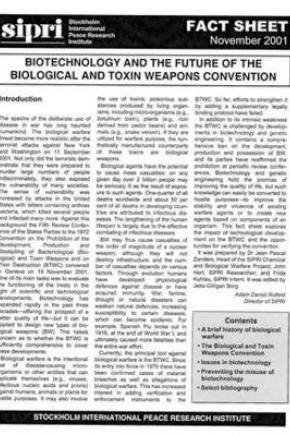Biotechnology and the Future of the Biological and Toxin Weapons Convention
The spectre of the deliberate use of disease in war has long haunted humankind. The biological warfare threat became more realistic after the terrorist attacks against New York and Washington on 11 September 2001. Not only did the terrorists demonstrate that they were prepared to murder large numbers of people indiscriminately, they also exposed the vulnerability of many societies. The sense of vulnerability was increased by attacks in the United States with letters containing anthrax bacteria, which killed several people and infected many more. Against this background the Fifth Review Conference of the States Parties to the 1972 Convention on the Prohibition of the Development, Production and Stockpiling of Bacteriological (Biological) and Toxin Weapons and on Their Destruction (BTWC) convened in Geneva on 19 November 2001. One of its main tasks was to evaluate the functioning of the treaty in the light of scientific and technological developments. Biotechnology has expanded rapidly in the past three decades—offering the prospect of a better quality of life—but it can be applied to design new types of biological weapons (BW). This raises concern as to whether the BTWC is sufficiently comprehensive to cover these developments.
Biological warfare is the intentional use of disease-causing micro-organisms or other entities that can replicate themselves (e.g., viruses, infectious nucleic acids and prions) against humans, animals or plants for hostile purposes. It may also involve the use of toxins: poisonous substances produced by living organisms, including micro-organisms (e.g., botulinum toxin), plants (e.g., ricin derived from castor beans) and animals (e.g., snake venom). If they are utilized for warfare purpose, the synthetically manufactured counterparts of these toxins are biological weapons.
Biological agents have the potential to cause mass casualties: on any given day over 2 billion people may be seriously ill as the result of exposure to such agents. One-quarter of all deaths worldwide and about 50 per cent of all deaths in developing countries are attributed to infectious diseases. The lengthening of the human lifespan is largely due to the effective combating of infectious diseases. BW may thus cause casualties of the order of magnitude of a nuclear weapon, although they will not destroy infrastructure, and the number of casualties depends on various factors. Through evolution humans have developed physiological defences against disease or have acquired immunity. War, famine, drought or natural disasters can weaken natural defences, increasing susceptibility to certain diseases, which can become epidemic. For example, Spanish Flu broke out in 1918, at the end of World War I, and ultimately caused more fatalities than the entire war effort.
Currently, the principal tool against biological warfare is the BTWC. Since its entry into force in 1975 there have been confirmed cases of material breaches as well as allegations of biological warfare. This has increased interest in adding verification and enforcement instruments to the BTWC. So far, efforts to strengthen it by adding a supplementary legally binding protocol have failed.
In addition to its intrinsic weakness the BTWC is challenged by developments in biotechnology and genetic engineering. It contains a comprehensive ban on the development, production and possession of BW, and its parties have reaffirmed the prohibition at periodic review conferences. Biotechnology and genetic engineering hold the promise of improving the quality of life, but such knowledge can easily be converted to hostile purposes—to improve the stability and virulence of existing warfare agents or to create new agents based on components of an organism. This fact sheet explores the impact of technological development on the BTWC and the opportunities for verifying the convention.
- A brief history of biological warfare
- The Biological and Toxin Weapons Convention
- Issues in biotechnology
- Preventing the misuse of biotechnology
- Select bibliography


